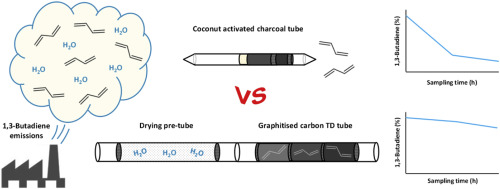当前位置:
X-MOL 学术
›
Atmos. Environ.
›
论文详情
Our official English website, www.x-mol.net, welcomes your feedback! (Note: you will need to create a separate account there.)
Evaluation of active sampling strategies for the determination of 1,3-butadiene in air
Atmospheric Environment ( IF 5 ) Pub Date : 2018-03-01 , DOI: 10.1016/j.atmosenv.2017.12.012 Laura Vallecillos , Alba Maceira , Rosa Maria Marcé , Francesc Borrull
Atmospheric Environment ( IF 5 ) Pub Date : 2018-03-01 , DOI: 10.1016/j.atmosenv.2017.12.012 Laura Vallecillos , Alba Maceira , Rosa Maria Marcé , Francesc Borrull

|
Abstract Two analytical methods for determining levels of 1,3-butadiene in urban and industrial atmospheres were evaluated in this study. Both methods are extensively used for determining the concentration of volatile organic compounds in the atmosphere and involve collecting samples by active adsorptive enrichment on solid sorbents. The first method uses activated charcoal as the sorbent and involves liquid desorption with carbon disulfide. The second involves the use of a multi-sorbent bed with two graphitised carbons and a carbon molecular sieve as the sorbent, with thermal desorption. Special attention was paid to the optimization of the sampling procedure through the study of sample volume, the stability of 1,3-butadiene once inside the sampling tube and the humidity effect. In the end, the thermal desorption method showed better repeatability and limits of detection and quantification for 1,3-butadiene than the liquid desorption method, which makes the thermal desorption method more suitable for analysing air samples from both industrial and urban atmospheres. However, sampling must be performed with a pre-tube filled with a drying agent to prevent the loss of the adsorption capacity of the solid adsorbent caused by water vapour. The thermal desorption method has successfully been applied to determine of 1,3-butadiene inside a 1,3-butadiene production plant and at three locations in the vicinity of the same plant.
中文翻译:

测定空气中 1,3-丁二烯的主动采样策略评估
摘要 本研究评估了测定城市和工业大气中 1,3-丁二烯含量的两种分析方法。这两种方法都广泛用于测定大气中挥发性有机化合物的浓度,并涉及通过固体吸附剂的活性吸附富集来收集样品。第一种方法使用活性炭作为吸附剂,并涉及用二硫化碳进行液体解吸。第二种涉及使用具有两个石墨化碳和一个碳分子筛作为吸附剂的多吸附剂床,并进行热解吸。通过对样品体积、1,3-丁二烯一次进入采样管的稳定性和湿度影响的研究,对采样程序的优化给予了特别关注。到底,与液体解吸方法相比,热解吸方法对 1,3-丁二烯显示出更好的重复性和检测限和定量限,这使得热解吸方法更适合分析工业和城市大气中的空气样品。但取样时必须用装有干燥剂的预制管进行取样,以防止水蒸气引起固体吸附剂吸附能力的损失。热解吸法已成功应用于 1,3-丁二烯生产厂内和同一工厂附近三个位置的 1,3-丁二烯的测定。这使得热解吸方法更适合分析工业和城市大气中的空气样本。但取样时必须用装有干燥剂的预制管进行取样,以防止水蒸气引起固体吸附剂吸附能力的损失。热解吸法已成功应用于测定 1,3-丁二烯生产厂内和同一工厂附近三个位置的 1,3-丁二烯。这使得热解吸方法更适合分析工业和城市大气中的空气样本。但取样时必须用装有干燥剂的预制管进行取样,以防止水蒸气引起固体吸附剂吸附能力的损失。热解吸法已成功应用于 1,3-丁二烯生产厂内和同一工厂附近三个位置的 1,3-丁二烯的测定。
更新日期:2018-03-01
中文翻译:

测定空气中 1,3-丁二烯的主动采样策略评估
摘要 本研究评估了测定城市和工业大气中 1,3-丁二烯含量的两种分析方法。这两种方法都广泛用于测定大气中挥发性有机化合物的浓度,并涉及通过固体吸附剂的活性吸附富集来收集样品。第一种方法使用活性炭作为吸附剂,并涉及用二硫化碳进行液体解吸。第二种涉及使用具有两个石墨化碳和一个碳分子筛作为吸附剂的多吸附剂床,并进行热解吸。通过对样品体积、1,3-丁二烯一次进入采样管的稳定性和湿度影响的研究,对采样程序的优化给予了特别关注。到底,与液体解吸方法相比,热解吸方法对 1,3-丁二烯显示出更好的重复性和检测限和定量限,这使得热解吸方法更适合分析工业和城市大气中的空气样品。但取样时必须用装有干燥剂的预制管进行取样,以防止水蒸气引起固体吸附剂吸附能力的损失。热解吸法已成功应用于 1,3-丁二烯生产厂内和同一工厂附近三个位置的 1,3-丁二烯的测定。这使得热解吸方法更适合分析工业和城市大气中的空气样本。但取样时必须用装有干燥剂的预制管进行取样,以防止水蒸气引起固体吸附剂吸附能力的损失。热解吸法已成功应用于测定 1,3-丁二烯生产厂内和同一工厂附近三个位置的 1,3-丁二烯。这使得热解吸方法更适合分析工业和城市大气中的空气样本。但取样时必须用装有干燥剂的预制管进行取样,以防止水蒸气引起固体吸附剂吸附能力的损失。热解吸法已成功应用于 1,3-丁二烯生产厂内和同一工厂附近三个位置的 1,3-丁二烯的测定。



























 京公网安备 11010802027423号
京公网安备 11010802027423号